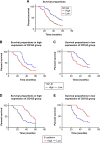High tumor-associated macrophages infiltration is associated with poor prognosis and may contribute to the phenomenon of epithelial-mesenchymal transition in gastric cancer
- PMID: 27418840
- PMCID: PMC4935103
- DOI: 10.2147/OTT.S103112
High tumor-associated macrophages infiltration is associated with poor prognosis and may contribute to the phenomenon of epithelial-mesenchymal transition in gastric cancer
Abstract
Background: Recent studies show that epithelial-mesenchymal transition (EMT) and tumor-associated macrophages (TAMs) contribute to the progression and poor prognosis of carcinoma through multiple mechanisms. Both inflammation and changing of epithelium have a close relationship with tumorigenesis of gastric cancer. However, the relevance between EMT and TAMs is still unclear in gastric cancer and needs more scientific research. This study is designed to explore the relationship between EMT and TAMs in gastric cancer.
Materials and methods: Immunohistochemistry was used to detect the expression of EMT-related proteins and TAM markers in cancer tissues and normal gastric tissues.
Results: High levels of EMT and TAMs infiltration are related to aggressive features and independent prognostic factors in gastric cancer, respectively. In addition, expression of the two indicators is associated with expression of transforming growth factor-β1 (TGF-β1). Infiltration of TAMs is also associated with EMT-related marker in gastric cancer.
Conclusion: Our results suggest that high levels of EMT and TAMs infiltration are related to aggressive features and independent prognostic factors in gastric cancer, respectively. A correlation was found between EMT- and TAM-related indicators, which may be associated with TGF-β signaling pathway. The level of TAMs infiltration plays an important role in gastric cancer, the markers of which can be used as prognostic indicators.
Keywords: E-cadherin; TGF-β1; gastric cancer; prognosis; tumor-associated macrophages.
Figures


References
-
- Torre LA, Bray F, Siegel RL, Ferlay J, Lortet-Tieulent J, Jemal A. Global cancer statistics, 2012. CA Cancer J Clini. 2015;65(2):87–108. - PubMed
-
- Bertuccio P, Chatenoud L, Levi F, et al. Recent patterns in gastric cancer: a global overview. Int J Cancer. 2009;125(3):666–673. - PubMed
-
- Chung HW, Jang S, Kim H, Lim JB. Combined targeting of high-mobility group box-1 and interleukin-8 to control micrometastasis potential in gastric cancer. Int J Cancer. 2015;137(7):1598–1609. - PubMed
-
- Allavena P, Sica A, Solinas G, Porta C, Mantovani A. The inflammatory micro-environment in tumor progression: the role of tumor-associated macrophages. Crit Rev Oncol Hematol. 2008;66(1):1–9. - PubMed
LinkOut - more resources
Full Text Sources
Other Literature Sources

